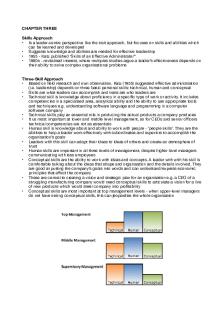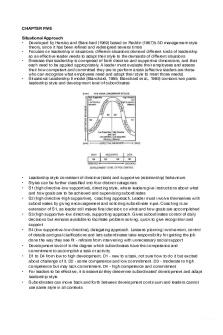Lecture 3 -Integrative Approach PDF

| Title | Lecture 3 -Integrative Approach |
|---|---|
| Course | Abnormal Psychology U |
| Institution | University of Guelph |
| Pages | 18 |
| File Size | 755.1 KB |
| File Type | |
| Total Downloads | 29 |
| Total Views | 147 |
Summary
Download Lecture 3 -Integrative Approach PDF
Description
CHAPTER 2 A MULTIDIMENSIONAL INTEGRATIVE APPROACH TO PSYCHOPATHOLOGY Please note that there are chunks of the chapter that we will not be reviewing in class today but you are responsible for this material (as per your syllabus).
Dr. C. Meghan McMurtry, C. Psych Info from Barlow et al. 2015 textbook unless otherwise noted. Chapter 2
1
MULTIDIMENSIONAL MODELS • “System” of reciprocal influences that cause and maintain suffering • Draws upon information from several sources • Interdisciplinary and integrative • View abnormal behaviour as multiply determined – Can’t consider factors in isolation 2 ADAPTED FROM 2012 Nelson Education Limited
MULTIDIMENSIONAL MODELS OF ABNORMAL • Biological factors (genetics, physiology, neurobiology) • Learning factors (conditioning, modelling) • Emotional factors • Cognitive factors • Social factors • Cultural factors 3 ADAPTED FROM 2015 Nelson Education Limited
Genes • Nature of Genes – Deoxyribonucleic acid (DNA) double helix – Normal cell: 23 pairs chromosomes – Dominant vs. recessive genes – Development and behaviour often polygenetic – Genetic contribution to psychopathology < 50% ADAPTED FROM 2012 Nelson Education Limited
Picture http://ghr.nlm.nih.gov/handbook/illustrations/dnastructure
Models: Gene-Environment Interactions Diathesis-Stress Model, Fig 2.2
OVERSIMPLIFIED Gene-Environment Correlation Model, Fig. 2.4
Epigenetics: Genes get turned on? Gene-Environment Interaction • Only some genes are “turned on” or “expressed” in a given cell – What genes are active is influenced by environmental context, social context etc.!
• May not be just for kids: adulthood plasticity as well
NEUROSCIENCE AND PSYCHOPATHOLOGY • Field of Neuroscience – Role of the nervous system in disease and behaviour
• Central Nervous System (CNS) – Brain and spinal cord
• Peripheral Nervous System (PNS) – Somatic and autonomic branches
8 ADAPTED FROM 2012 Nelson Education Limited
Neurons • Neuronal structure – Soma: Cell body – Dendrites: Branches receive messages from other neurons – Axon: Trunk of neuron that sends messages to other neurons – Axon terminals (terminal endings): Buds at end of axon from which chemical messages are sent – Synapses (synaptic cleft) : Small gaps that separate neurons (next slide)
• Neurons function electrically, but communicate chemically – Neurotransmitters: chemical messengers
ADAPTED FROM 2012 Nelson Education Limited
NEUROSCIENCE AND THE CENTRAL NERVOUS SYSTEM Copyright © 2012 by Nelson Education Limited
10
PERIPHERAL NERVOUS AND ENDOCRINE SYSTEMS • Somatic Branch of PNS: – Voluntary muscles & movement
• Autonomic Branch of the PNS: – Sympathetic & parasympathetic branches – Regulate cardiovascular system, body temperature, endocrine system. Involved in digestion.
• Endocrine System: Hormones • Hypothalamic-Pituitary-Adrenalcortical Axis (HPA axis) – Integration of endocrine & nervous system function 11 ADAPTED FROM 2012 Nelson Education Limited
NEUROTRANSMITTERS • Functions of Neurotransmitters (NT) – Agonists: increase activity (act like the NT or block reuptake into neuron) – Antagonists: reduce activity (block NT or receptors) – Inverse agonists: produce opposite effects than the NT (e.g., increase other biochemicals which reduce NT) Most drugs are either agonistic or antagonistic 12 ADAPTED FROM 2012 Nelson Education Limited
BRAIN FUNCTIONING: IMPLICATIONS FOR PSYCHOPATHOLOGY • Relations between brain and abnormal behaviour – E.g., obsessive compulsive disorder
• Therapy can change brain structure and function – Medications and psychotherapy
• Experience can change brain function and maybe structure 13 ADAPTED FROM 2012 Nelson Education Limited
BEHAVIOURAL AND COGNITIVE SCIENCE • Conditioning and Cognitive Processes – Learned helplessness – Modelling and vicarious learning
• Cognitive-Behavioural Therapy
Thoughts
Feelings
More here when we focus on anxiety & mood disorders and stress
Behaviours 14
Components of Emotion, Fig 2.16
t © 2015 by Nelson Education Limited
CULTURAL, SOCIAL, AND INTERPERSONAL FACTORS • Cultural Factors – Influence the form and expression of normal and abnormal behaviour
• Gender Effects – E.g., phobias affect many more women than men; major depression also much more common in women
16 ADAPTED FROM 2012 Nelson Education Limited
CULTURAL, SOCIAL, AND INTERPERSONAL FACTORS • Social Relationships – Frequency and quality related to mortality, disease, and psychopathology • Pets are important too
– Interpersonal psychotherapy
• Stigma of psychopathology is culturally, socially, and interpersonally situated
17 ADAPTED FROM 2012 Nelson Education Limited
LIFE-SPAN AND DEVELOPMENTAL INFLUENCES OVER PSYCHOPATHOLOGY • Life-Span Developmental Perspective – Addresses developmental changes • Influence and constrain what is normal and abnormal
• Principle of Equifinality – Concept in developmental psychopathology – Several paths to a given outcome Path A Path B Path C
Outcome
18 ADAPTED FROM 2012 Nelson Education Limited...
Similar Free PDFs

Lecture 3 -Integrative Approach
- 18 Pages

Lecture 2 - Skills Approach
- 3 Pages

Lecture 2 - Situational Approach
- 2 Pages
Popular Institutions
- Tinajero National High School - Annex
- Politeknik Caltex Riau
- Yokohama City University
- SGT University
- University of Al-Qadisiyah
- Divine Word College of Vigan
- Techniek College Rotterdam
- Universidade de Santiago
- Universiti Teknologi MARA Cawangan Johor Kampus Pasir Gudang
- Poltekkes Kemenkes Yogyakarta
- Baguio City National High School
- Colegio san marcos
- preparatoria uno
- Centro de Bachillerato Tecnológico Industrial y de Servicios No. 107
- Dalian Maritime University
- Quang Trung Secondary School
- Colegio Tecnológico en Informática
- Corporación Regional de Educación Superior
- Grupo CEDVA
- Dar Al Uloom University
- Centro de Estudios Preuniversitarios de la Universidad Nacional de Ingeniería
- 上智大学
- Aakash International School, Nuna Majara
- San Felipe Neri Catholic School
- Kang Chiao International School - New Taipei City
- Misamis Occidental National High School
- Institución Educativa Escuela Normal Juan Ladrilleros
- Kolehiyo ng Pantukan
- Batanes State College
- Instituto Continental
- Sekolah Menengah Kejuruan Kesehatan Kaltara (Tarakan)
- Colegio de La Inmaculada Concepcion - Cebu












